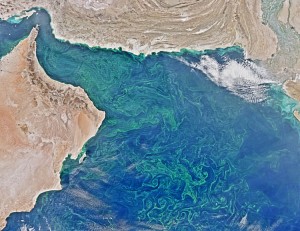Keeping Oceans Healthy
Worldwide, a billion people rely on the oceans for their primary source of protein, but in many areas the oceans are in crisis. Pollution from urban sewers, farm chemical runoff, and rising levels of carbon dioxide are changing ocean chemistry and affecting the health of marine life.
As seaside communities start to see the consequences, Lamont scientists are helping explain what is happening and providing community leaders and industries with the knowledge to begin developing solutions.
Dangerous Blooms
In the Arabian Sea, a growing “dead zone” linked to water pollution has allowed plankton uniquely suited to low-oxygen water to take over the base of the food chain. Their rise to dominance over the last decade could be disastrous for the predator fish that sustain 120 million people living along the sea’s edge.
Lamont’s Helga do Rosario Gomes, Joaquim Goes, and colleagues were the first to document the rapid rise of this plankton, called green Noctiluca scintillans. It is an unusual dinoflagellate that eats other plankton and draws energy from the Sun via microscopic algae living within its cells.

Winter blooms of Noctiluca are so vast they can be seen from space. (Norman Kuring, NASA)
In a 2015 study, the scientists hypothesize that a tide of nutrient-rich sewage flowing from booming cities on the Arabian Sea is feeding Noctiluca’s growth by expanding an oxygen-starved dead zone the size of Texas. They show how the microscopic algae living within Noctiluca cells allow the plankton to exploit this dead zone.
In winter, Noctiluca’s thick blooms color the Arabian Sea an emerald green, from the shores of Oman to India and Pakistan. Until recently, photosynthetic diatoms supported the Arabian Sea food chain; zooplankton grazed on the diatoms and were, in turn, eaten by fish. In the early 2000s, that changed. The researchers began to see vast blooms of Noctiluca and a steep drop in diatoms and dissolved oxygen in the water. Within a decade, Noctiluca had virtually replaced diatoms at the base of the food chain, marking the start of a colossal ecosystem shift.
To understand the key to Noctiluca ’s success, the researchers spent three successive winters sampling blooms and performing experiments. Putting Noctiluca and its diatom competitors in oxygen-starved water, they found that Noctiluca’s carbon-fixation rate rose by up to 300 percent while that of the diatoms fell by nearly as much.
Arabian Sea fisheries have suffered during many of the same years. Whether Noctiluca or overfishing is to blame, one major factor stands out: massive sewage flows into the Arabian Sea as the coastal population has exploded. Mumbai’s population has doubled to 21 million in the last decade. The region now sends 63 tons of nitrogen and 11 tons of phosphorus into the Arabian Sea each day. Karachi’s 15 million people send 70 percent of their wastewater into the sea untreated. Much of the fertilizer used to boost yields on farms in South Asia also eventually washes into rivers that drain into the sea.
From the Arabian Sea to the Gulf of Mexico to Chesapeake Bay, dead zones are on the rise globally and now cover more than 95,000 square miles. Shifting ocean currents due to climate change can make the problem worse by dredging up nutrients from the ocean bottom.
“It’s unusual for Noctiluca to bloom in the open sea and return year after year,” said Andy Juhl. “All of these observations suggest that something dramatic has changed in the Arabian Sea.”
Ocean Acidification
Rising carbon dioxide levels are another challenge affecting oceans and marine life worldwide.
The oceans have taken up about a quarter of the carbon dioxide humans have put in the atmosphere over the last two hundred years. As CO2 levels have increased, the acidity of ocean water has risen, with serious consequences for shell-building creatures such as oysters and tiny pteropods that are a key part of the marine food chain.
Studies show that as carbon dioxide levels have increased in the atmosphere over the past two centuries, seawater has become less saturated with aragonite and calcite, which several kinds of sea creatures use to build their skeletons and shells. The average pH of seawater has also fallen from about 8.2 to 8.1, about a 30 percent increase in acidity on pH’s logarithmic scale.
“Ocean acidification has effects, in the end, for our food chain. We see it in pteropods – tiny marine snails are an important source of food for juvenile Pacific salmon. They are growing thinner shells, and the shells malform under acidified conditions. We see it in sea urchins, in crabs. We see it in a number of organisms that secrete calcium carbonate shells; they are having a hard time making their shells,” said Bäerbel Hönisch.
A recent global study led by Lamont’s Taro Takahashi mapped acidification changes around the world and found the lowest pH levels in the cold waters off Siberia and Alaska, the Pacific Northwest, and Antarctica. The scientists found that over extensive ocean areas, pH had been declining by a mean rate of about 0.02 pH units per decade, not counting the polar regions. The concentration of CO2 had increased at a rate consistent with the mean increase in atmospheric CO2 concentration over the past 20 years.
“This result suggests that the global oceans are being acidified primarily in response to the atmospheric CO2 increase,” Takahashi and his co-authors wrote.
Scientists know from studying deep ocean sediment cores that acidification has wreaked havoc on marine life before. About 56 million years ago, during the Paleocene-Eocene Thermal Maximum, temperatures rose and there is evidence that coral reefs collapsed and many deep-sea benthic foraminifers, which produce shells of calcium carbonate, disappeared. “There is indication that sea water acidified at the time,” Hönisch said. “What we’ve realized is that the acidification at that time was about as large as what we’re predicting for the end of this century.”